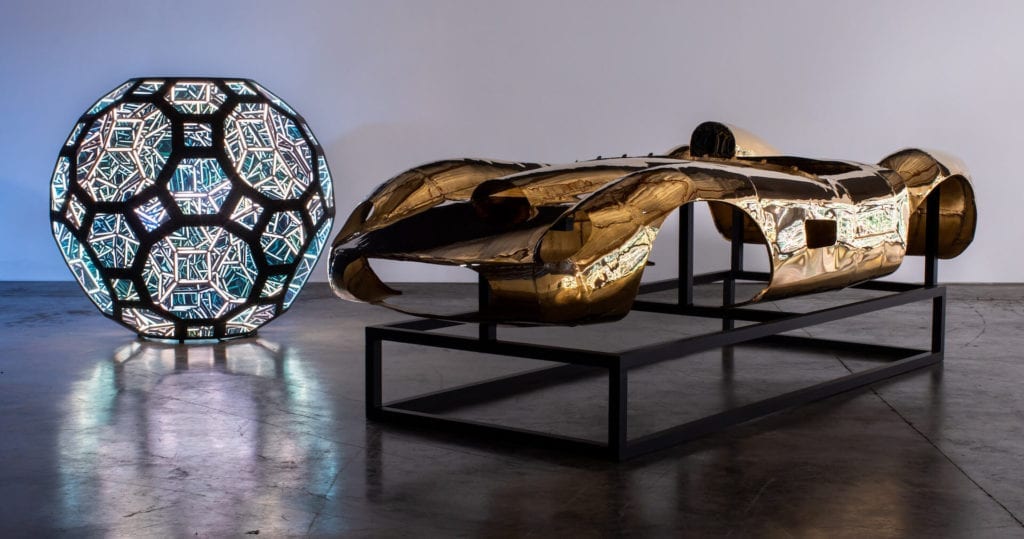Menu
WRU JOURNAL

Volume 1, Issue 1
Menu
WRU JOURNAL

Volume 1, Issue 2





Anthony Haden-Guest (born 2 February 1937) is a British writer, reporter, cartoonist, art critic, poet, and socialite who lives in New York City and London. He is a frequent contributor to major magazines and has had several books published including TRUE COLORS: The Real Life of the Art World and The Last Party, Studio 54, Disco and the Culture of the Night.
Anthony James put together the Birch Series in 2005 while living in New York. These are oblong vitrines, each of which encloses a standing grove of segments of the white-barked trees, and this work made it clear that James, self-described as a Minimalist/Formalist, had something singularly his own to offer, a way of using light as an art material, which differentiated his work from the bevy of others who had taken cues from Robert Smithson, Carl Andre, and—for James most especially—Donald Judd.
I had met James, a fellow London transplant, then in his mid 20s, some years before. I liked his energy, his outspoken ideas, and we would hang out from time to time, go gallery hopping or whatever. So it was one day when he picked me up at my place on 80th and Park in a borrowed Ferrari. He reminds me that the car was yellow and that he hit the gas as we were driving Downtown on Fifth. “You turned to me and said, ‘Slow down! I’ve lost too many friends like this!’” he told me. I laughed and said he probably wasn’t going that fast. Wrong. “I guess I took it to 120,” he said. “It was pretty idiotic.” More than just a casual memory this, it signalled the immersion of James in the culture of ultra-muscle cars, and the model was much to the point. “It was a Ferrari 355 Spider,” he said. “Like my car, the car I set on fire.”
Yes, there’s a story here. James was then living on the Lower East Side. “I was at 229 East 11th Street,” he says. “Fun Gallery was on the ground floor. They showed Basquiat really early. I was first floor. But that was just a weird coincidence. The apartment was only 400 square feet. The car was worth more than the apartment.” It was a rough neighbourhood then. Hadn’t he been concerned that somebody might thieve his $150,000 car? Or slash the panels?
“Not at all,” he said. “I was pretty rough and ready myself. And I knew the local community. And nobody was going to touch Anthony’s car. But then I decided to take it to Kingston and set it on fire.” So the destruction of a great automobile was a performance. How had it come about? Was there a lightbulb moment?
“It was this idea of passion,” James says. “Passion usually comes from your childhood. I came from Essex. We did not have cars like that. But I would see Miami Vice and it had a Ferrari car. I never got to see one until I was 11. But I was obsessed with these beautiful unusual objects.”
He locates another source in a friendship during his time at Central St Martins, the London art college. “I got to know the KLF,” he said. “They were a band, they had like five number ones or something crazy.” I knew of KLF. They had been a duo, one of the biggest bands in the UK in the early 90s, who became famous way outside the music world on August 23 1994, when they had themselves filmed burning a million pounds sterling on the Scottish island of Jura. They then toured the UK, explaining just why. James had known them well, and says the KLF action was on his mind but that his action was to be significantly different. “They were burning a false icon,” he says. “But to me Ferrari is an icon. And an icon is associated with passion. And passion really means pain and sacrifice. And to sacrifice the car was the gesture.”

His Ferrari was black. “I like my cars black on black. Like the inside of a coffin on a moonless night,” he says. How long had he had it? “Just a year.”James had it transported to Kingston, a quiet town in the Hudson Valley, not chosen because it had been the first capital of New York State, but because a friend lived there. “I did donuts until I hit a tree and dented it up,” he says. “Then I drove it to the center of a wood. They were birch trees but that was coincidence. Then I doused it in gasoline and I set it on fire. And then I left it under the snow for three or four months.”
Two artist actions, both half a century ago, come to mind. On the evening of July 24, 1970, John Baldessari and a cluster of friends and students gathered all the “Ab Ex-ish” paintings he had made between May 1953 and March 1966 that he owned, took them to a crematorium in San Diego, California, and had them burned. He called this “The Cremation Project.” He was 39. On 26 April 1971, Chris Burden, a 25-year-old student at UC Irvine, padlocked himself inside a locker there and stayed for five days, linked by a tube to a five gallon water bottle in the locker above, as also to an identical empty bottle in the locker below for his pee. The careers of Baldessari and Burden were both kick-started by these actions. Baldessari went on to a fifty-year career in Conceptual art and the editors of his 2012 Catalogue Raisonné would write that he was probably best known for that “single, creative act of destruction.” The fiery end of Anthony James’ Ferrari was also consequential. The crumpled remains now occupy a double vitrine, flanked by birch trees and he called the piece “Kalos Thanatos,” which is Greek for Beautiful Death. It has gone on to have an interesting afterlife.
Bill Drummond, one of the KLF duo, told the BBC ten years after their burn that he had regrets. “I said I’m done with materiality,” Anthony James had observed in advance of his own burn. “But then of course I did the exact opposite. I took a car that was worth $150,000 and destroyed it. And then I sold it for $450,000, something like that. Everything I like to do is about contradiction.” The aftereffects of Kalos Thanatos on James would be closer to those experienced by John Baldessari and Chris Burden. James had by then moved to Los Angeles. “LA has a history of Light & Space art,” he said.
He set up speedily. “I wanted to make some new art work and I needed to work with some engineers. I met Peter Carlson. He is the guy who made the Dog series for Jeff Koons. You know, those gigantic balloon dogs. He took me under his wing.” Soon James was making the pieces which would make him an international presence.
Many artists develop their abstractions from observations “IRL” as when Piet Mondrian painted and drew trees. Anthony James works from ideas. Indeed when he uses a natural element that will also represent an idea. Such his signature birch trees. Why had he chosen birches, I asked? “The birch is a metaphor for unity because the roots of all the trees are all linked,” he said. “They are basically one unit.” And the strength of an entire piece depends on the delivery of a powerful idea. “I want to give someone an experience they have never seen before,” he says. “I want to show the impossible —infinity, the cosmos. I want to give someone an experience they have never seen before. How do you do that?”
Portals, his luminous series, Icosahedrons, twenty-sided aggregations of equilateral triangles, that was how he did that.
“Plato said that there were five perfect forms and the icosahedron was one of them.” James says. The Icosahedrons have been shown world-wide. So was his next series, Morphic Fields. And last year James returned to an early love. Yes, motorcars. And yes, Ferraris.
The new series is called Repose, the cars being shown at rest, not in a Futurist mimicry of motion, and James made sculptures that replicated the bodies of three classic Ferrari bodies, the 1957 250TR, the 1962 250 GTO, and the 1967 P4. “I chose cars that were five years apart,” he says. He worked in bronze, aluminum, and copper. And he did so without any computer assist. “I did everything by eye,” he says. Adding: “And by hand. And it’s all hand-hammered. I beat every panel with a hammer. Each panel is only 16 inches long and each takes 600 hits of the hammer. Beating out the panels was the hardest part. Then I welded them together. And then I mirror-polished each to within an inch of its life.
Just why had Anthony James returned to motorcars?
“Perfect form,” he said. “A car is a portal. It’s a perfect example of transcendence.”